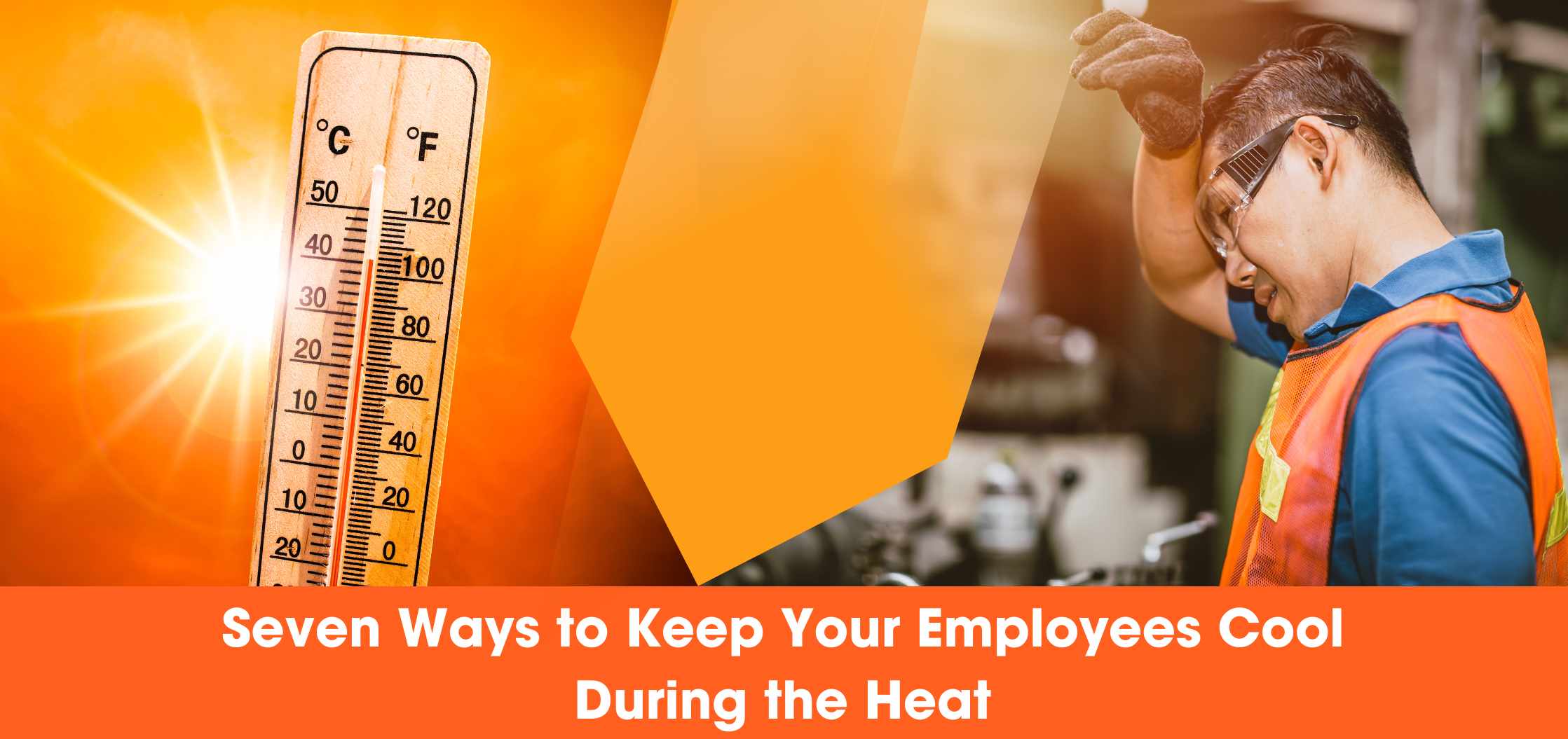Six Ways to Keep Your Employees Cool During the Heat
2nd May 2024
Debilitating or even fatal infections might result from working outside in hot temperatures. However, by adhering to the proper safety precautions, you can avoid ailments like heat exhaustion, heat stroke, and cramps. Use these seven suggestions to assist your staff stay cool during the heatwave without endangering their safety.

1. Make sure you're hydrated
As one of the main causes of heat exhaustion is dehydration, make sure to provide clean, cool drinking water to your employees. Workers should stay away from caffeinated drinks like coffee and soda and instead consume electrolyte drinks and water.
Employees should arrive at work hydrated as well. They might not be able to give their bodies adequate water during the day if they arrive at work dehydrated. Moreover, workers should begin drinking water throughout the shift regardless of when they start to feel thirsty. Physical performance might suffer from dehydration even if the person is unaware of it.
Workers can stay hydrated while working in the heat by consuming eight ounces of water every fifteen to twenty minutes. Assure that staff members are aware that they shouldn't consume more than 48 ounces of liquid in a single hour. This much drinking can result in a blood salt concentration that is dangerously low. Lastly, in order to replenish the fluids lost through perspiration, employees should drink enough water after work. Hydrating after work is crucial for maintaining health because it can take hours for a person to consume enough water to rehydrate.
2. Promote Weather-Related Clothing
Making sure your employees are dressed appropriately for the weather is another way to assist them keep cool during the heat. Although loose-fitting clothing is not recommended for workers, it does allow for more air circulation throughout the body.
Work Numerous elements on t-shirts meant for warm or hot weather help to cool the body. Mesh side panels, for instance, increase ventilation. Improved perspiration evaporation cools the skin and dissipates body heat when worn in moisture-wicking fabric. Humidity causes sweat to stay on the skin, making it impossible for the body to maintain a healthy, safe temperature.
These cooling characteristics can also be found in high-visibility clothing designed for hot conditions. Additionally, reflective tape and bright colours that increase visibility shield workers from harm both during the day and at night. Make that the material is permeable and that employees are wearing the appropriate ANSI-rated safety gear for the job.
3. Provide instruction on illnesses related to heat
Workers and supervisors alike had to get training on illnesses brought on by the heat. By the time the course is over, participants ought to know how to prevent heat illness, recognise its symptoms, and know how to treat it. Heat stress can impair fine motor skills, cause illness, require hospitalisation, or perhaps have more serious effects.
Conditions brought on by heat include the following:
- Heat Cramps
- Heat Injury
- Heat exhaustion
- Heatstroke
It's crucial to create a safer workplace to prevent heat disease. However, a heat illness emergency plan should also be in place at your place of employment. Inform employees and managers about the plan. The course should cover what to do in the event of a heat disease, how to call for emergency assistance, and how to administer the proper first aid.
4. Modify the Workload and Level of Intensity
On warm days, employers should urge employees to perform shorter shifts and take regular breaks. This can be accomplished by adding more workers to a job, dividing shifts, or rotating staff. Managers ought to counsel staff members to minimise physical exertion, for example, by lowering manual handling speeds.
If at all feasible, plan your job for earlier in the day, but keep in mind that the early morning hours are typically more humid. Worker tiredness may also rise with early start hours. Postpone non-essential outdoor tasks to days when the heat index is lower.
Finally, don't count on staff members to pace themselves to accomplish safe job. Instead, create a work and relaxation schedule specific to your workplace and enforce it. Depending on the temperature and degree of physical activity, the National Institute for Occupational Safety and Health (NIOSH) publishes schedules that specify how long workers should take breaks and work.
5. Adjust Employees
The process of increasing one's tolerance to heat is known as heat acclimatisation. In a hot environment, increasing an employee's task gradually is the greatest method to help them acclimatise. Heat acclimatisation enhances sweating efficiency, lessens the negative effects of heat exposure on critical organs, and makes physical labour in the heat more comfortable for workers.
All workers must become used to working in the heat, but new hires are more susceptible to heat illness. It takes one to two weeks for the acclimatisation process. However, after roughly a week of not working in the heat, people lose their acclimatisation and revert to their baseline.
Allocate 7 to 14 days for staff to progressively extend their work hours. You can split the minimum two hours of heat exposure needed for acclimatisation into two distinct one-hour sessions. Throughout the acclimatisation phase, the body will adapt to the amount of labour required. The worker is better prepared for that degree of physical exertion in the heat by doing light or quick physical labour. Encourage higher-intensity physical activity throughout the acclimatisation phase for longer or more taxing tasks. Additionally, employees who eat regular meals and stay hydrated adjust to their new environment more quickly.
6. Make Breaks Mandatory to Recover
Make sure there are spaces that are completely shaded or air-conditioned for employees to relax and cool off. Shaded spaces, air-conditioned cars and buildings, adjacent tents, and spaces with fans and misters are examples of cool spots.
The frequency and duration of worker rest breaks are regulated by OSHA. As heat stress increases, take longer and more frequent rests. Workers should be able to recover from the heat during their breaks. To quantify heat stress in direct sunshine, find the Wet Bulb Globe Temperature (WBGT) for your location using OSHA's heat hazard assessment. Additionally, make safer working circumstances by utilising the heat-related sickness prevention programme at your place of employment.
The quantity of time a worker needs to relax and cool down depends on their level of physical activity and specific risk factors. Take these things into account and make sure that employees don't skip breaks, particularly during the summer.
Workers are kept safe by making sure they drink enough water, wear safety gear appropriate for the conditions, and recognise the symptoms of heat illness. Reduce workplace hazards as an employer by designing a safer space, establishing a thoughtful timetable, and enforcing rest periods. By putting these procedures in place, you can give your staff a more secure, effective, and pleasurable place to work.
Do you require high-visibility shirts that maintain employees' comfort and professional appearance? We have a selection of fashionable shirts at Work Wear Club that will keep employees cool during the summer. Purchase high-quality hi-vis apparel from us right now!

 United Arab Emirates Dirham
United Arab Emirates Dirham
 Australian Dollar
Australian Dollar
 Canadian Dollar
Canadian Dollar
 Euro
Euro
 US Dollar
US Dollar
 FREE UK DELIVERY ON ALL ORDERS OVER £75
FREE UK DELIVERY ON ALL ORDERS OVER £75




